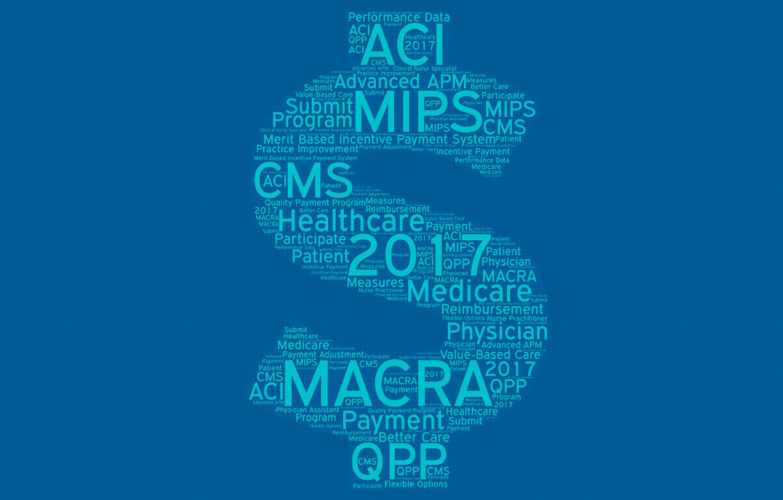
MIPS Facts & Overview
Uncategorized - 1 March, 2017
The Merit-based Incentive Payment System (MIPS) is the new payment mechanism in which eligible clinicians earn a performance-based payment adjustment (positive or negative) to their Medicare payments. It is important to note that MIPS adjustments are budget neutral, therefore equal numbers of positive and negative payment updates will occur.
MIPS allows Medicare clinicians to be paid for providing high quality, efficient care through success in four performance categories:
- Quality
- Improvement Activities
- Advancing Care Information
- Cost
Many groups face confusion as to reporting requirements for 2017, which categories they need to focus on, and how the new definitions apply to them. Below is an overview of each reporting category, and details regarding patient facing and hospital based MIPS eligible clinicians:
QUALITY (replacement of PQRS)
Clinicians choose 6 measures to report, including one outcome measure, if applicable. If an outcome measure is not available, another high priority measure should be reported. CMS has removed the cross-cutting measure reporting requirement for eligible clinicians.
IMPROVEMENT ACTIVITIES (new performance category)
In this category, clinicians are rewarded for practice improvement activities. Most MIPS participants will need to attest to completing up to 4 improvement activities during 2017.
ADVANCING CARE INFORMATION (replacement of Meaningful Use/EHR Incentive Program)
For clinicians who are not eligible for re-weighting of this category to zero, CMS requires 5 measures be reported to establish a base score, accounting for 50% of the final ACI score. Additional performance scores are available for reporting up to nine measures and other activities. Non-patient facing and/or hospital based clinicians are exempt from reporting this category.
COST (replacement of Value-Based Modifier)
CMS re-weighted the Cost category to zero for 2017. Beginning in 2018, the Cost category score will gradually increase from 0% to 30% by 2021
PATIENT FACING VERSUS NON-PATIENT FACING
CMS defines a patient-facing encounter as an instance in which a MIPS eligible clinician billed for services such as office visits, outpatient visits, and procedure codes under the Medicare Physician Fee Schedule.
A Non-Patient Facing MIPS Eligible Clinicians is:
- An individual MIPS eligible clinician that bills 100 or fewer patient-facing encounters during the non-patient facing determination period
- A group, provided that more than 75% of the clinicians billing under the group’s TIN meet the definition of a non-patient facing individual MIPS eligible clinician during the non-patient facing determination period
HOSPITAL BASED MIPS ELIGIBLE CLINICIANS
A MIPS hospital-based clinician is defined as a MIPS eligible clinician who furnishes greater or equal to 75% of his or her covered professional services in sites of service identified by Place of Service (POS) codes 21, 22, and 23 – inpatient hospital, on campus outpatient hospital, or emergency room setting.
For hospital-based clinicians, reporting for the Advancing Care category is optional. If this category is not reported, the ACI score will automatically be re-weighted to zero.
REPORTING OPTIONS FOR 2017 – TRANSITION YEAR
CMS has relaxed the reporting requirements for 2017 MIPS participation and have developed a “pick your pace” set of options:
- Don’t participate: you will receive a negative 4% payment adjustment
- Test: submit a minimum amount of data (e.g. 1 quality measure) and avoid a downward payment adjustment
- Partial: submit 90 days of 2017 data – you may earn a neutral or positive payment adjustment
- Full: submit a full year of data and you may earn a positive payment adjustment
Individual Reporting: MIPS eligible clinicians who report on an individual basis will have their payment adjustment based on their individual performance.
Group Reporting: If MIPS data is reported with a group, the group will receive one payment adjustment based on the group’s performance.
PAYMENT ADJUSTMENTS
In the first year (2019), negative adjustments can be no more than 4%, with positive adjustments generally up to 4% (scaled up or down to achieve budget neutrality).
Positive and negative adjustments increase over time, maximum ranges as follows:
+/- 5% 2020
+/- 7% 2021
+/- 9% 2022 and beyond
For years 2019-2024, the law establishes a $500 million bonus pool designed to provide additional incentives of up to 10 percent for “xceptional performers”. CMS has stated exceptional performance payments will be made to MIPS eligible clinicians whose performance meets or exceeds a threshold final score of 70.

